Stainless steel dry goods, do not distinguish 201, 202, 301, 302, 304
Stainless Steel (Stainless Steel) is short for stainless steel, resistant to air, steam, water and other weak corrosion media or stainless steel called stainless steel; And the chemical corrosion medium (acid, alkali, salt and other chemical erosion) corrosion steel called acid - resistant steel.
In practice, the steel that is resistant to weak corrosion is often called stainless steel, and the steel that is resistant to chemical corrosion is called acid-resistant steel. Because of the difference in chemical composition between the two, the former is not necessarily resistant to chemical corrosion, and the latter is generally rust free. The corrosion resistance of stainless steel depends on the alloying elements contained in the steel.

Common categories:
It is usually divided into:
Austenitic stainless steel, ferritic stainless steel, Martensitic stainless steel.
On the basis of these three basic metallostructures, duplex steels, precipiting-hardened stainless steels and high alloy steels with iron content less than 50% are derived for specific needs and purposes.
1, Austenitic stainless steel.
The matrix is mainly austenitic structure (CY phase) of face-centered cubic crystal structure, non-magnetic, mainly through cold processing to make it strengthened (and may lead to some magnetic) stainless steel. The American Iron and Steel Institute is labeled with 200 and 300 series numbers, such as 304.
2, iron type stainless steel.
The matrix is based on the ferrite structure of the body-centered cubic crystal structure (phase a), which is magnetic and generally cannot be hardened by heat treatment, but cold processing can make it slightly strengthened stainless steel. The American Iron and Steel Institute is labeled 430 and 446.
3, Martensite stainless steel.
The matrix is martensite structure (body-centered cubic or cubic), magnetic stainless steel whose mechanical properties can be adjusted by heat treatment. The American Iron and Steel Institute is numbered 410, 420, and 440. Martensite has an austenitic structure at high temperatures, which is capable of transforming into martensite (i.e. hardened) when cooled to room temperature at an appropriate rate.
4, austenite - ferrite (duplex) stainless steel.
The matrix has both austenite and ferrite two-phase structure, among which the content of the less phase matrix is generally greater than 15%, has magnetic, can be strengthened by cold processing of stainless steel, 329 is a typical duplex stainless steel. Compared with austenitic stainless steel, duplex steel has high strength, and its resistance to intergranular corrosion, chloride stress corrosion and pitting corrosion is significantly improved.
5, precipitation hardening stainless steel.
Stainless steel with austenite or martensite structure as the matrix and hardened by precipitation hardening treatment. The American Iron and Steel Institute has a 600 series number, such as 630, which is 17-4PH.
Generally, in addition to alloys, the corrosion resistance of austenitic stainless steel is relatively excellent, in the low corrosive environment, can be used ferritic stainless steel, in the mildly corrosive environment, if the material is required to have high strength or high hardness, martensite stainless steel and precipitation hardening stainless steel can be used.
